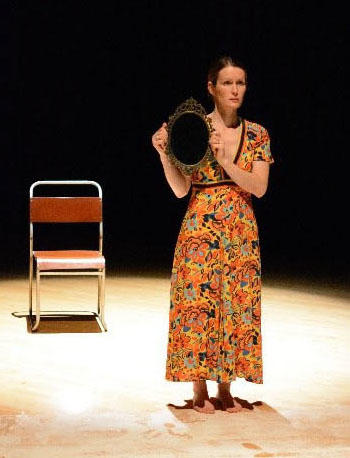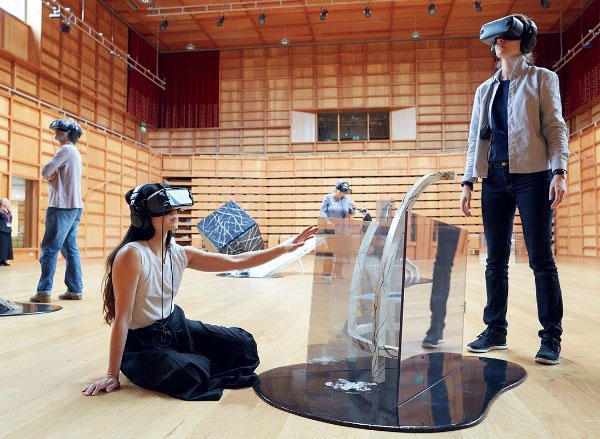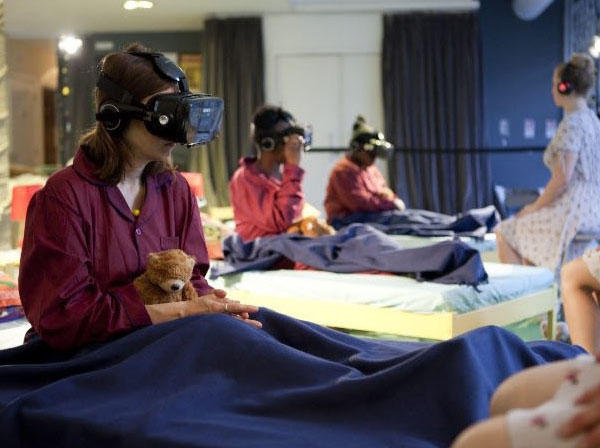Visiting Artist Kerryn Wise explains the symbiotic relationship between drama and virtual reality and how these two disciplines are changing the way performance takes place.

Kerryn recently ran a workshop with University of Worcester students allowing them to be plunged into the world of virtual reality.
Immersive and one on one performance has grown in popularity over the last ten years. The opportunity to experience this type of work is much more accessible, especially in London. From large scale immersive environments that audiences are free to move within, to small one on one experiences where a more direct relationship is made between audience member and performer, more companies and artists are creating work that challenges the role of the audience and offers participatory elements. Immersive performance is most well-known by Punchdrunk and their highly successful production Sleep No More, a stylistic, film noir adaptation of Shakespeare’s Macbeth, which gained great reviews.
The development of Virtual Reality (VR) technologies is moving into the mainstream and merging gaming with immersive theatre experiences; from full body immersive VR games such as The Void to Zero Latency, the free-roam, multiplayer VR experience where you race to survive a Zombie invasion. Alongside this, over the past two years as VR technologies have become more affordable and available, there is now a range of exciting work emerging by contemporary theatre practitioners and choreographers using VR to take audiences into new immersive worlds. As the creative content and possibilities for this medium develop, artists are beginning to experiment and are creating innovative new experiences for audiences.
Punchdrunk themselves have recently began using VR within their immersive work and created Believe Your Eyes with Samsung in 2017; a multi-sensory, one to one performance that blurred real and virtual space, using real actors, film and soundscape to create a ghostly experience that left audiences amazed and unsettled. Together with other large-scale immersive events such as Somnai, which took place in 2018 in a large warehouse in London, there are some amazing experiences being developed by theatre companies which offer more intimate and interactive experiences.

Whist by A?E
One work that attempts to explore merging VR, 360 film and physical theatre, with a more interactive audience experience is Whist by A?E.
Whist combines 360 video and augmented reality (layering of computer graphics over a view of the real world - think Pokemon Go!) that allows audiences to move within a real art installation comprising large sculptures. 360 video scenes which contain physical theatre performances inspired by Sigmund Freud, are triggered using gaze-based navigation.
By looking at real objects within the installation space, audiences must move around the material space to get close to different objects, and the action of looking at them triggers the next scene, thus creating a unique VR experience for each participant, depending on which route they take through the installation. Whist premiered in 2017 at the Gulbenkian, Canterbury and continues to tour internationally.

Goodnight, Sleep Tight by ZU-UK
Goodnight, Sleep Tight by ZU-UK, a company with a history of creating immersive and digital theatrical experiences. Goodnight, Sleep Tight merges live performance and 360 video, and was first shown at the Theatre Royal Stratford in 2017.
Audience members are invited to take part in an immersive, participatory experience that involves being put to bed in pyjamas with a cup of hot chocolate, facilitated by live actors. Once put to bed, participants see the world through the eyes of a child, watching a 360 video via a VR headset that merges the live and virtual experience of a bedtime routine, by linking the visuals to live action taking place around the participants beds. This gradually merges into drone footage of the surrounding landscape.
Frogman by Curious Directive
In Frogman, the performance is framed by the idea that the audience are the communal jury in a missing person’s / murder case and are being shown video evidence through the VR headsets and witness interviews with key characters.
The piece alternates between live performance and VR footage piecing together different elements of the story. Both the VR and live sections help develop the unfolding narrative in the work, yet also offers an element of play and participation through the role the audience are given in making their own conclusions as the jury in the case.
Students and Virtual Reality
Students on our Drama and Performance course have had the chance to develop new theatrical experiences using a range of exciting innovative technologies in a second year Digital Performance module.
Students have worked with choreographer and digital artist Kerryn Wise who has recently made Exposure, a one to one performance that merged 360 video and live dance performance. Our students have been exploring VR, 360 video and live performance to create adaptations of Shakespeare’s A Midsummer Night’s Dream; learning how to devise, film, develop narratives and edit 360 video, and to merge this with elements of live performance, working at the cutting edge of new theatrical experience.
Blog author Kerryn Wise is a dance artist, lecturer and choreographer based in the East Midlands. She was invited to run a workshop on the integration of Virtual Reality into performance for our Drama and Performance BA (Hons) students.
Image credits
Immersive 360 video dance performance Exposure by Kerryn Wise. Image: Victor Simao
Whist Image: Paul Plews
All views expressed in this blog are the Academic’s own and do not represent the views, policies or opinions of the University of Worcester or any of its partners.